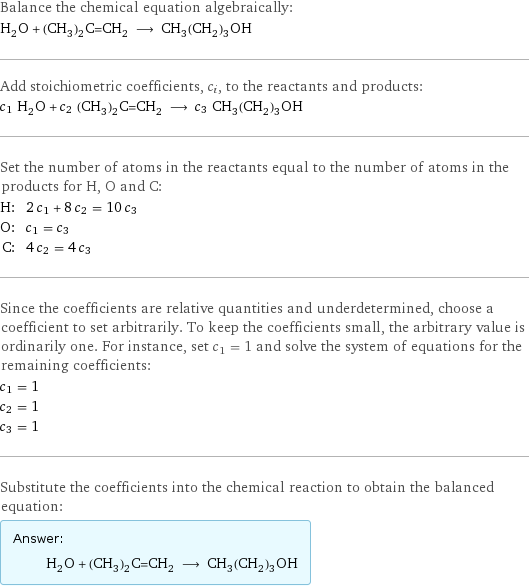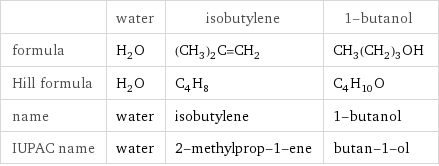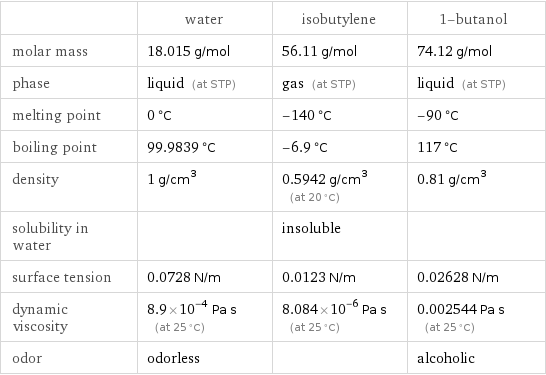Input interpretation

H_2O water + (CH_3)_2C=CH_2 isobutylene ⟶ CH_3(CH_2)_3OH 1-butanol
Balanced equation

Balance the chemical equation algebraically: H_2O + (CH_3)_2C=CH_2 ⟶ CH_3(CH_2)_3OH Add stoichiometric coefficients, c_i, to the reactants and products: c_1 H_2O + c_2 (CH_3)_2C=CH_2 ⟶ c_3 CH_3(CH_2)_3OH Set the number of atoms in the reactants equal to the number of atoms in the products for H, O and C: H: | 2 c_1 + 8 c_2 = 10 c_3 O: | c_1 = c_3 C: | 4 c_2 = 4 c_3 Since the coefficients are relative quantities and underdetermined, choose a coefficient to set arbitrarily. To keep the coefficients small, the arbitrary value is ordinarily one. For instance, set c_1 = 1 and solve the system of equations for the remaining coefficients: c_1 = 1 c_2 = 1 c_3 = 1 Substitute the coefficients into the chemical reaction to obtain the balanced equation: Answer: | | H_2O + (CH_3)_2C=CH_2 ⟶ CH_3(CH_2)_3OH
Structures

+ ⟶
Names

water + isobutylene ⟶ 1-butanol
Equilibrium constant
![Construct the equilibrium constant, K, expression for: H_2O + (CH_3)_2C=CH_2 ⟶ CH_3(CH_2)_3OH Plan: • Balance the chemical equation. • Determine the stoichiometric numbers. • Assemble the activity expression for each chemical species. • Use the activity expressions to build the equilibrium constant expression. Write the balanced chemical equation: H_2O + (CH_3)_2C=CH_2 ⟶ CH_3(CH_2)_3OH Assign stoichiometric numbers, ν_i, using the stoichiometric coefficients, c_i, from the balanced chemical equation in the following manner: ν_i = -c_i for reactants and ν_i = c_i for products: chemical species | c_i | ν_i H_2O | 1 | -1 (CH_3)_2C=CH_2 | 1 | -1 CH_3(CH_2)_3OH | 1 | 1 Assemble the activity expressions accounting for the state of matter and ν_i: chemical species | c_i | ν_i | activity expression H_2O | 1 | -1 | ([H2O])^(-1) (CH_3)_2C=CH_2 | 1 | -1 | ([(CH3)2C=CH2])^(-1) CH_3(CH_2)_3OH | 1 | 1 | [CH3(CH2)3OH] The equilibrium constant symbol in the concentration basis is: K_c Mulitply the activity expressions to arrive at the K_c expression: Answer: | | K_c = ([H2O])^(-1) ([(CH3)2C=CH2])^(-1) [CH3(CH2)3OH] = ([CH3(CH2)3OH])/([H2O] [(CH3)2C=CH2])](../image_source/2acbdd3ea67f93458dc4477fa8e86a7d.png)
Construct the equilibrium constant, K, expression for: H_2O + (CH_3)_2C=CH_2 ⟶ CH_3(CH_2)_3OH Plan: • Balance the chemical equation. • Determine the stoichiometric numbers. • Assemble the activity expression for each chemical species. • Use the activity expressions to build the equilibrium constant expression. Write the balanced chemical equation: H_2O + (CH_3)_2C=CH_2 ⟶ CH_3(CH_2)_3OH Assign stoichiometric numbers, ν_i, using the stoichiometric coefficients, c_i, from the balanced chemical equation in the following manner: ν_i = -c_i for reactants and ν_i = c_i for products: chemical species | c_i | ν_i H_2O | 1 | -1 (CH_3)_2C=CH_2 | 1 | -1 CH_3(CH_2)_3OH | 1 | 1 Assemble the activity expressions accounting for the state of matter and ν_i: chemical species | c_i | ν_i | activity expression H_2O | 1 | -1 | ([H2O])^(-1) (CH_3)_2C=CH_2 | 1 | -1 | ([(CH3)2C=CH2])^(-1) CH_3(CH_2)_3OH | 1 | 1 | [CH3(CH2)3OH] The equilibrium constant symbol in the concentration basis is: K_c Mulitply the activity expressions to arrive at the K_c expression: Answer: | | K_c = ([H2O])^(-1) ([(CH3)2C=CH2])^(-1) [CH3(CH2)3OH] = ([CH3(CH2)3OH])/([H2O] [(CH3)2C=CH2])
Rate of reaction
![Construct the rate of reaction expression for: H_2O + (CH_3)_2C=CH_2 ⟶ CH_3(CH_2)_3OH Plan: • Balance the chemical equation. • Determine the stoichiometric numbers. • Assemble the rate term for each chemical species. • Write the rate of reaction expression. Write the balanced chemical equation: H_2O + (CH_3)_2C=CH_2 ⟶ CH_3(CH_2)_3OH Assign stoichiometric numbers, ν_i, using the stoichiometric coefficients, c_i, from the balanced chemical equation in the following manner: ν_i = -c_i for reactants and ν_i = c_i for products: chemical species | c_i | ν_i H_2O | 1 | -1 (CH_3)_2C=CH_2 | 1 | -1 CH_3(CH_2)_3OH | 1 | 1 The rate term for each chemical species, B_i, is 1/ν_i(Δ[B_i])/(Δt) where [B_i] is the amount concentration and t is time: chemical species | c_i | ν_i | rate term H_2O | 1 | -1 | -(Δ[H2O])/(Δt) (CH_3)_2C=CH_2 | 1 | -1 | -(Δ[(CH3)2C=CH2])/(Δt) CH_3(CH_2)_3OH | 1 | 1 | (Δ[CH3(CH2)3OH])/(Δt) (for infinitesimal rate of change, replace Δ with d) Set the rate terms equal to each other to arrive at the rate expression: Answer: | | rate = -(Δ[H2O])/(Δt) = -(Δ[(CH3)2C=CH2])/(Δt) = (Δ[CH3(CH2)3OH])/(Δt) (assuming constant volume and no accumulation of intermediates or side products)](../image_source/e15e0eb34912820852480f49906f8934.png)
Construct the rate of reaction expression for: H_2O + (CH_3)_2C=CH_2 ⟶ CH_3(CH_2)_3OH Plan: • Balance the chemical equation. • Determine the stoichiometric numbers. • Assemble the rate term for each chemical species. • Write the rate of reaction expression. Write the balanced chemical equation: H_2O + (CH_3)_2C=CH_2 ⟶ CH_3(CH_2)_3OH Assign stoichiometric numbers, ν_i, using the stoichiometric coefficients, c_i, from the balanced chemical equation in the following manner: ν_i = -c_i for reactants and ν_i = c_i for products: chemical species | c_i | ν_i H_2O | 1 | -1 (CH_3)_2C=CH_2 | 1 | -1 CH_3(CH_2)_3OH | 1 | 1 The rate term for each chemical species, B_i, is 1/ν_i(Δ[B_i])/(Δt) where [B_i] is the amount concentration and t is time: chemical species | c_i | ν_i | rate term H_2O | 1 | -1 | -(Δ[H2O])/(Δt) (CH_3)_2C=CH_2 | 1 | -1 | -(Δ[(CH3)2C=CH2])/(Δt) CH_3(CH_2)_3OH | 1 | 1 | (Δ[CH3(CH2)3OH])/(Δt) (for infinitesimal rate of change, replace Δ with d) Set the rate terms equal to each other to arrive at the rate expression: Answer: | | rate = -(Δ[H2O])/(Δt) = -(Δ[(CH3)2C=CH2])/(Δt) = (Δ[CH3(CH2)3OH])/(Δt) (assuming constant volume and no accumulation of intermediates or side products)
Chemical names and formulas

| water | isobutylene | 1-butanol formula | H_2O | (CH_3)_2C=CH_2 | CH_3(CH_2)_3OH Hill formula | H_2O | C_4H_8 | C_4H_10O name | water | isobutylene | 1-butanol IUPAC name | water | 2-methylprop-1-ene | butan-1-ol
Substance properties

| water | isobutylene | 1-butanol molar mass | 18.015 g/mol | 56.11 g/mol | 74.12 g/mol phase | liquid (at STP) | gas (at STP) | liquid (at STP) melting point | 0 °C | -140 °C | -90 °C boiling point | 99.9839 °C | -6.9 °C | 117 °C density | 1 g/cm^3 | 0.5942 g/cm^3 (at 20 °C) | 0.81 g/cm^3 solubility in water | | insoluble | surface tension | 0.0728 N/m | 0.0123 N/m | 0.02628 N/m dynamic viscosity | 8.9×10^-4 Pa s (at 25 °C) | 8.084×10^-6 Pa s (at 25 °C) | 0.002544 Pa s (at 25 °C) odor | odorless | | alcoholic
Units
